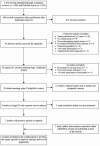Equity-Specific Effects of Interventions to Promote Physical Activity among Middle-Aged and Older Adults: Development of a Collaborative Equity-Specific Re-Analysis Strategy
- PMID: 31480561
- PMCID: PMC6747170
- DOI: 10.3390/ijerph16173195
Equity-Specific Effects of Interventions to Promote Physical Activity among Middle-Aged and Older Adults: Development of a Collaborative Equity-Specific Re-Analysis Strategy
Abstract
Reducing social inequalities in physical activity (PA) has become a priority for public health. However, evidence concerning the impact of interventions on inequalities in PA is scarce. This study aims to develop and test the application of a strategy for re-analyzing equity-specific effects of existing PA intervention studies in middle-aged and older adults, as part of an international interdisciplinary collaboration. This article aims to describe (1) the establishment and characteristics of the collaboration; and (2) the jointly developed equity-specific re-analysis strategy as a first result of the collaboration. To develop the strategy, a collaboration based on a convenience sample of eight published studies of individual-level PA interventions among the general population of adults aged ≥45 years was initiated (UK, n = 3; The Netherlands, n = 3; Belgium, n = 1; Germany, n = 1). Researchers from these studies participated in a workshop and subsequent e-mail correspondence. The developed strategy will be used to investigate social inequalities in intervention adherence, dropout, and efficacy. This will allow for a comprehensive assessment of social inequalities within intervention benefits. The application of the strategy within and beyond the collaboration will help to extend the limited evidence regarding the effects of interventions on social inequalities in PA among middle-aged and older adults.
Keywords: equity impact assessment; intervention-generated inequalities; interventions; middle-aged adults; older adults; physical activity; social inequalities.
Conflict of interest statement
The authors declare no conflict of interest. The funder had no role in the design of the study; in the collection, analyses, or interpretation of data; in the writing of the manuscript, or in the decision to publish the results.
References
-
- Mackenbach J.P., Stirbu I., Roskam A.-J.R., Schaap M.M., Menvielle G., Leinsalu M., Kunst A.E., European Union Working Group on Socioeconomic Inequalities in Health Socioeconomic inequalities in health in 22 European countries. N. Engl. J. Med. 2008;358:2468–2481. doi: 10.1056/NEJMsa0707519. - DOI - PubMed
-
- Dalstra J.A.A., Kunst A.E., Borrell C., Breeze E., Cambois E., Costa G., Geurts J.J., Lahelma E., Van Oyen H., Rasmussen N.K., et al. Socioeconomic differences in the prevalence of common chronic diseases: An overview of eight European countries. Int. J. Epidemiol. 2005;34:316–326. doi: 10.1093/ije/dyh386. - DOI - PubMed
-
- World Health Organization (WHO) Physical Activity Promotion in Socially Disadvantaged Groups: Principles for Action. WHO Regional Office for Europe; Copenhagen, Denmark: 2013. [(accessed on 11 July 2019)]. Phan Work Package 4 Final Report. Available online: http://www.euro.who.int/__data/assets/pdf_file/0005/185954/E96817eng.pdf.
-
- Gidlow C., Johnston L.H., Crone D., Ellis N., James D. A systematic review of the relationship between socio-economic position and physical activity. Health Educ. J. 2006;65:338–367. doi: 10.1177/0017896906069378. - DOI
-
- Hillsdon M., Lawlor D.A., Ebrahim S., Morris J.N. Physical activity in older women: Associations with area deprivation and with socioeconomic position over the life course: Observations in the British Women’s Heart and Health Study. J. Epidemiol. Community Health. 2008;62:344–350. doi: 10.1136/jech.2006.058610. - DOI - PubMed
Publication types
MeSH terms
Grants and funding
LinkOut - more resources
Full Text Sources
Medical


